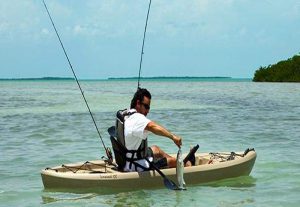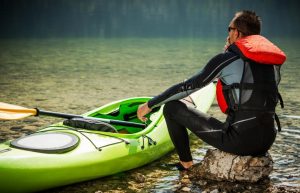Kayaking is one of the best ways that you can feel connected with the natural world around you. There’s really nothing better than setting off on a journey, either on your own or with a partner, where you can truly appreciate the beauty of the outdoors.
Kayaking provides this, as well as that much needed peace and quiet from the everyday hustle and bustle of modern life. But, as relaxing and tranquil as it can be, it can sometimes be ruined if you don’t have the right equipment for the experience you want.
It’s imperative that you have the right kayak for the sort of journey you want to go on! Why is this? It’s because these days’ certain types of kayaks are engineered especially for certain types of excursions.
For example, a white-water kayak is made to handle the tumultuous nature of rapids. This means it is heavy, durable and protected. This sort of kayak wouldn’t be the best when it came to leisurely paddling down a tranquil lake or river.
A good kayaker will know exactly what it is they want out of their model.
What is an inflatable kayak?
An inflatable kayak is a kayak made from flexible, but durable plastic. To utilise kayaks like this, they need to be inflated using an air pump or by hand and will only really work if they are at maximum inflation. They are mostly used by those who are looking for a fun, inexpensive kayak that can be used by a lot of different people.

How much does an inflatable kayak cost?
Inflatable kayaks cost usually anywhere from $100 – $500 depending on the size and quality of the model. Though inflatable kayaks are often seen as inferior to classic kayaks, manufacturers use multitude of seats in inflatable models as a bit of a price boost.
Advantages of an inflatable kayak.
The advantages of owning an inflatable kayak include:
- They are not as much hassle as classic kayaks.
- They weigh exceedingly less and are much more portable than any other sort of kayak.
- They are much more approachable for kids and beginners than normal kayaks.
- Check They can be rolled up to a minute size and carried around very easily.
- Check There portable nature means they can be taken to anywhere that the user wishes.
- Check Inflatable kayaks are a lot easier to climb into after capsizing.
- Check Inflatable kayaks often forgive little errors that classic kayaks often don’t.
Are inflatable kayaks safe?
Firstly, it must be recognised that there is an inherent danger when being on a body of water anyway. One must always be focused and have their wits about them, as water is often unpredictable and unforgiving.
Safety tips for being on water include:
- Stay with your group.
- Try to stay inside of the boat.
- Don’t panic if you do touch the water.
- Check Circle Remember to bring a buoyancy vest.
- Check Circle Stay calm and alert those you are with if you have any trouble.
Now we know how to be safe on the water, we must also be aware of the dangers of kayaking in general. When kayaking, remember:
- If you are in a group, communicate regularly.
- Don’t leave anyone behind, it is not a race.
- Do not paddle unless instructed to do so.
- Times Circle Make yourself heard clearly.
- Times Circle Tell an instructor or an adult if you are having trouble.
The only real other danger when dealing with an inflatable kayak is the possibility of it bursting. Though they are made of very durable material, it is still an eventuality that could happen. After all, we do not always know what lies at the bottom of a body of water.
If you do find that your kayak losing air, then make sure you have a puncture repair kit handy. If at all possible, get yourself to the nearest bank or path near the water and get you and your partners out of the boat, the puncture will be easily fixed there.
If this isn’t an option, then you need to assess the situation further. Assign yourself a series of steps as part of a fixing process, or if you are with others, assign them individual jobs. Someone must locate the puncture and seek to fix it either permanently or temporarily.
One person can focus on exiling any unwelcome water from the craft as this will help it to stay afloat. If there is anyone else aboard, they can try and find ways of getting the craft out of the water and getting everyone to safety.
What to do if you can’t fix the puncture.
If you can’t find a way of fixing the puncture or keeping your craft afloat, then it is probably time to get to land. If you are on a calm river, it might be quite easy to get out of your boat and make your way over to the edge. From their, it’s just about hoisting yourself out of the water and trying to get your kayak to safety.
If you are on a bit more of an energetic river or stream, then there are a number of things you need to do. One of the best things you can do is look for anywhere on the bank that will be able to help. If there are launch points up and down the river you’re on then there should be people around too.
Alert them to your situation and they can try and put some sort of rescue into action. If you can’t see anyone the best thing that you can do is try and make your way to the edge of the water and find something to grab hold of. It can either be with your hands or something in the water with your paddle.
Anything that will allow you to stop your kayak from picking up speed or continuing down the river. If your boat has deflated to the point where it is becoming a hindrance, the best thing for you to do is leave as you will be able to move better without hanging onto it.

What can I do to assist if it gets this urgent?
There are a number of things you can do pre-excursion to help out an emergency situation. One of these things would be to check with local services about the weather conditions on the day of your trip. If there are any adverse conditions on the horizon they will be able to tell you. They will also tell you if there are any out of bounds places that you shouldn’t really explore.
You can also make sure there is someone with you who is trained and able to give CPR if needs be. Though this isn’t imperative, it can definitely help out a situation.
Well, now that you are a bit more knowledgeable about the safety hazards of an inflatable kayak, all that’s left to say is have fun on your trip! Have a great time, but always remember to pack the necessities and also to stay focused, as you never know when you might need to spring into action.






